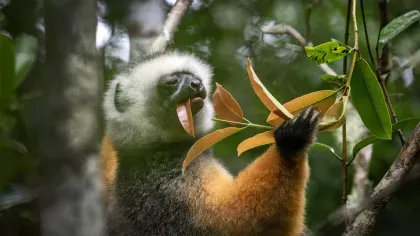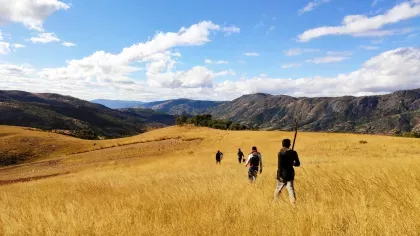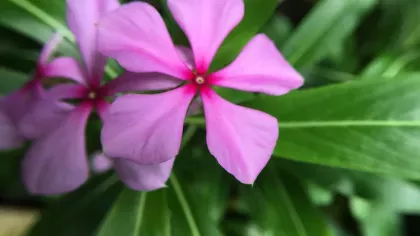12 February 2024
Saving a critically endangered orchid of Madagascar
Kew is working with local people to prevent the extinction of Madagascan orchid, Angraecum longicalcar.

Spectacular, white-flowered Angraecum longicalcar, is endemic to Madagascar – it can only be found there, like more than 90% of the nearly 1,000 Madagascan orchid species.
One of the largest-flowered orchids in Madagascar, Angraecum longicalcar is also thought to have the longest spur of any orchid species (which is where it gets its name: longicalcar meaning ‘long spur’).
Angraecum longicalcar occurs in three regions in the Central Highlands of Madagascar: Itasy, Tsiroanomandidy and Ambatofinandrahana, but its numbers were dwindling. In 2014, just nine clumps remained, with only six bearing flowering spikes.
So, researchers from the Kew Madagascar Conservation Centre (KMCC, Kew’s third side in Madagascar), launched a pivotal project to conserve and protect the species for the future. They based their work at Ambatofinanadrahana, where the largest wild population of A. longicalcar was found.

Critically endangered
Using the International Union for the Conservation of Nature’s Red List (IUCN Red List) criteria, A. longicalcar was assessed as Critically Endangered.
The species was at imminent risk of extinction if urgent conservation work was not prioritised.
Like a large proportion of species in Madagascar, Angraecum longicalcar is restricted to a small number of locations in the wild. It is lithophytic, meaning it grows on rock – only found on rocky outcrops of marble at 1,000–1,200m above sea level.
The main threats to the survival of the species are the annual grassland fires that ravage these areas, and the unsustainable collection of the plant, with its striking blooms, for local and international trade.

Hand-pollination
Strongly night-scented, and with such a long spur, A. longicalcar is adapted to attract a night-active moth with a long proboscis to pollinate its flowers, like most other Angraecum species including A. sesquipedale and A. sororium.
Since wild plants do not seem to produce seedpods if left to their own devices after flowering, it is thought that the natural pollinator of A. longicalcar is now extinct, another victim of habitat loss and change.
But hand-pollination of flowers can yield enough healthy seeds for in vitro propagation (growing plants in a controlled, artificial environment) and seed storage.
Kew collected seed from the wild plants for storage at the Madagascan national seedbank (Silo National des Graines Forestières) and Millennium Seed Bank at Wakehurst, to secure the species for the future.
And work germinating A. longicalcar seed in the lab led to 400 young plants being raised at the Parc Botanique et Zoologique de Tsimbazaza (PBZT), the botanic garden in Antananarivo.

Community involvement
Once the plants were large enough to leave Antananarivo, work to reintroduce them into the wild began to supplement the few remaining wild plants.
150 plants were taken on the long overland journey by Land Rover to Ambatofinandrahana in 2011 and 2014 and grown-on in a specially built shade house at the local primary school.
This sparked a new programme of environmental education where local people, including the primary schoolchildren, were taught about the importance of endemic species like A. longicalcar, and the role local people can play in protecting and monitoring their environment.
After nine months of growing and acclimatisation in the school shade house, the young orchids were planted out, by KMCC and local people, onto a local ridge with a similar habitat to the remaining wild population, where they could be protected and monitored.
The local people in Ambatofinandrahana have taken on the protection of the remaining wild plants plus the reintroduced plants, by managing the sites as a community, hand-pollinating the orchids to encourage seedlings to be produced in situ, creating and reinforcing firebreaks around the sites, and growing vegetable crops on parcels of land nearby.
With the engagement and support of local people, Angraecum longicalcar is now facing a more secure future in Madagascar.
Meanwhile, work continued at the botanic garden in Antananarivo to grow another 200 plants as a future source of plants for reintroduction, seed production, and public display.

Making good progress
Expeditions in 2014 and 2015 allowed KMCC researchers to check on the growth and survival of the plants in the original population, and at the new site.
The reintroduced plants were found to be growing well, producing new green leaves. In 2015, 90% of reintroduced plants were surviving well, and one of the reintroduced plants was even producing a flower spike for the first time.
A. longicalcar is now facing a more secure future in Madagascar, protected ex situ and in the wild, and able to flower and produce seedlings – with a little help from its guardians!




